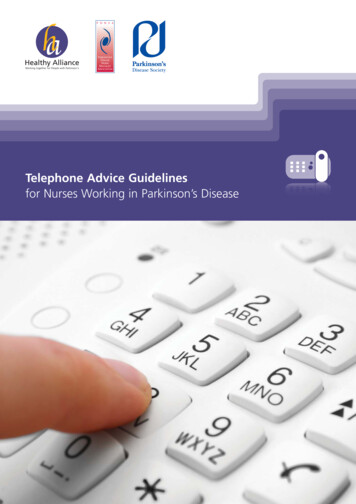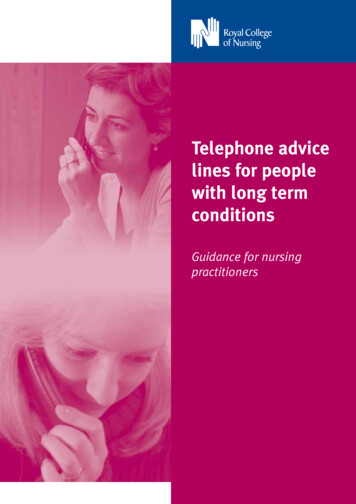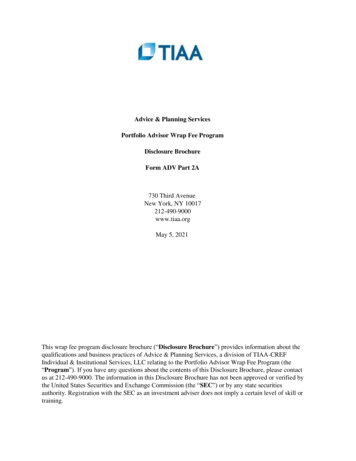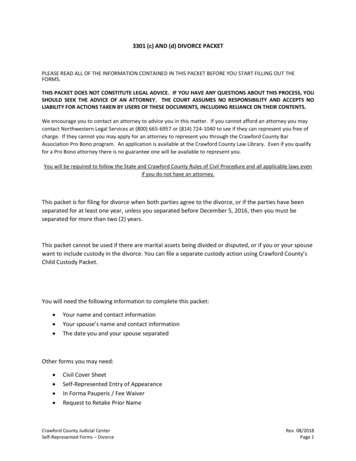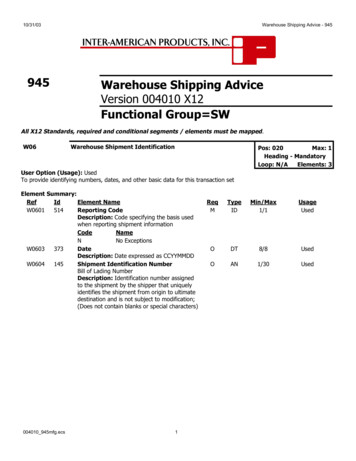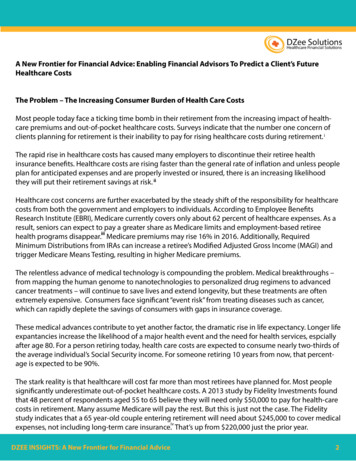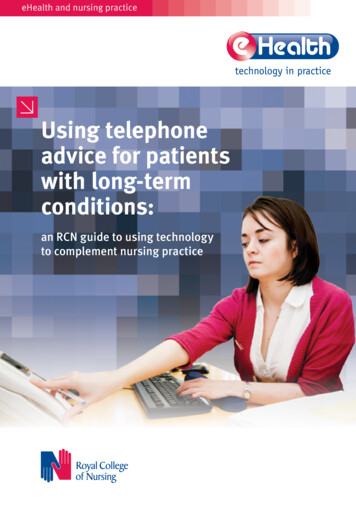
Transcription
eHealth and nursing practiceUsing telephoneadvice for patientswith long-termconditions:an RCN guide to using technologyto complement nursing practice
RCN Legal DisclaimerThis publication contains information, advice and guidance to help members of the RCN. It isintended for use within the UK, but readers are advised that practices may vary in each countryand outside the UK.The information in this booklet has been compiled from professional sources, but its accuracy is notguaranteed. While every effort has been made to ensure that the RCN provides accurate and expertinformation and guidance, it is impossible to predict all the circumstances in which it may be used.Accordingly, the RCN shall not be liable to any person or entity with respect to any loss or damagecaused or alleged to be caused directly or indirectly by what is contained in or left out ofthis information and guidance.Published by the Royal College of Nursing, 20 Cavendish Square, London, WIG ORN 2012 Royal College of Nursing. All rights reserved. Other than as permitted by law no part of thispublication may be reproduced, stored in a retrieval system, or transmitted in any form or by anymeans electronic, mechanical, photocopying, recording or otherwise, without prior permission ofthe Publishers or a licence permitting restricted copying issued by the Copyright Licensing Agency,Saffron House, 6-10 Kirby Street, London EC1N 8TS.This publication may not be lent, resold, hiredout or otherwise disposed of by ways of trade in any form of binding or cover other than that in whichit is published, without the prior consent of the Publishers.Using telephone advice for patients with long-term conditions
Contents1. Introduction: the benefits of telephone advice12. Your guide to offering telephone advice services23. Types of telephone advice services24. Ten questions to ask before you begin35. Principles of good practice56. Setting up your telephone advice service67. Ongoing training and support78. Evaluation and audit79. Promoting your telephone advice service810. Conculsion911. Notes10For informationThe term health care practitioner is used throughout this document to include all practitioners who deliver healthcare services across health and social care settings: clinicians, nurse practitioners, registered nurses, healthcare support workers.Using telephone advice for patients with long-term conditions
1. Introduction: the benefits oftelephone adviceTelephone advice lines can help to improvepatient access to services, and reduce theneed for more frequent face-to-face contact.For patients with long-term conditions,(LTCs), telephone advice can improveaccess to coaching and care managementadvice (including palliative care). Thebenefits include speedier symptom checks,better medication monitoring and quickerresponsive care, tailored to meetan individual’s needs. As a stand-alone1health offer or as part of a wider rangeof eHealth services, telephone advicecan help to instil confidence in patientsfor better self-management to enhance theirhealth and wellbeing.Please refer to the overview guidance Usingtechnology to complement nursing practice:a guide for health care practitioners (004228) for more information and advice.Using telephone advice for patients with long-term conditions
2. Your guide to offering telephoneadvice servicesThis guide provides health carepractitioners with an initial framework forbuilding or redesigning a telephone adviceservice. It focuses on meeting your localarea needs, where tailor-made, patientspecific enhancement complements thegeneral advice on LTCs provided by yourlocal GP surgery, NHS Direct, NHS 24 inScotland, NHS Health in Wales and theNHS OwnHealth service for people withdiabetes, cardiovascular disease, heartfailure, and chronic obstructive pulmonarydisease (COPD).This guide is not intended to replace primarycare consultations, surgical pre-treatment,triage services or patient-led charitableorganisation telephone services. It is notto be considered an alternative to A&Ecall-out services. To supplement this advice,health care practitioners should also seekinformation and best practice examples fromspecialists in the field.For a helpful overview of the principlesof establishing an eHealth service thatuses information and communicationstechnology (ICT) to enhance health caredelivery, the RCN has produced overarchingguidance on using technology to deliversafe and effective health care for patientswith LTCs: Using technology to complementnursing practice (004 228).3. Types of telephone advice servicesYour telephone advice service could takemany forms – from a dedicated dial-inadvice line (patients use their landline,mobile or specialised telephone equipmentto call for local advice) to a practitionercall-out service offering patients or carerspersonalised care control. For instance: telephone reminders aboutappointments, medicationsor treatmentsdirect dial number for patients to askspecific questions about their LTCsand general health issues, leadingto a personal response, consultationor referral direct dial for dealing with urgentsituations requiring immediate action automated advice and healthmanagement guidance on issuesrelated to LTCs automated information andsignposting to other availableservices and organisations.Using telephone advice for patients with long-term conditions2
4. Ten questions to ask before you beginBefore you establish a new telephoneadvice service, or review an existingone, you should plan ahead and be clearabout your objectives. Your professionalprinciples of practice should be at theheart of all services. Use the following tenquestions as a helpful starting point:4. If there is a clear need, what type ofservice will suit – direct responseor answer phone – and what will itsagreed service levels be?1. Looking at your local community –its geography, social, cultural andhealth issues – what is the potentialfor telephone advice, and is the ICTavailable to support it?6. What will happen if the advice line isclosed or out of order?2. What are your own patient group’sneeds for service provision within localand national NHS policy, includingclinical governance frameworks?3. What telephone advice and supportcurrently exists – for example, voluntaryor medical services – and how dopatients use them?5. Will support and advice be extended tothe patient’s family and carers, primaryand secondary care?7. How will the service deal withemergency calls?8. What training is needed for serviceproviders and how will it be funded?9. How will the service be monitored,reviewed and audited to maintainquality and standards?10. How will you promote the service, itsaims and objectives, to patients andpotential users?www.yhhiec.org.uk/telehealttoolkit/3Using telephone advice for patients with long-term conditions
You can also find excellent examples andgood practice in setting up a telephoneadvice service from the Yorkshire & HumberHealth Innovation & Education Cluster’sTelehealth toolkit. The telehealth resourcehas been designed to support healthprofessionals set up a new service. Itprovides information about technologyand service models specifically for peoplewith long-term conditions.Key contacts to involveto look at your patient group’s accessto the technology needed for a remoteconsultation – not all patients will haveaccess to, or be comfortable using, mobiletelephony. Your service design mayneed to focus on the use of a patient’slandline only. Also, you should considerthe telephone number patients would useto access your advice service. There aredifferent costs to the patient dialling 0345,0800, 0845 or geographic numbers, whichcould impact patient buy-in to the service.Collaboration is key for the success of yourtelephone advice. To ensure alignment,talk to your multi-professional clinicalteam and local patient groups and makesure you have access to the best medicalexpertise for support when complexproblems arise. There are key contactsyou will want to involve in your planningand preparation, including all nursingpractitioners who will be involved indelivering telephone advice.These key contacts are:1. ICT infrastructure manager2. ICT customer relationship manager3. web team manager4. management information analyst5. infrastructure support manager.For more details on these key contacts,please refer to the overview guidanceUsing technology to complementnursing practice: a guide for healthcare practitionersOther issues to considerThere will be other issues specific toyour area and patient group that youwill want to consider in your planningphase. For example, it will be importantUsing telephone advice for patients with long-term conditions4
5. Principles of good practiceLike other eHealth services, telephoneadvice must follow best practice thatreinforces your professional principlesand codes of practice at all times.GovernanceThe service plan must comply with theNursing and Midwifery Council (NMC)Code of professional conduct.View the he-code-in-fullYou should also ensure that an up-to-dateorganisational policy exists for patientprivacy and confidentiality, including theuse of landline and mobile phones, andrestricting the use of Skype which is nota secure line and so unsuitable for usein this instance.Read the Good Governance Institute’sBetter care for people with long-termconditions: the quality and goodgovernance of telehealth services:www.good-governance.org.uk/Downloads/GGI Tunstall Longtermconditions.pdfAccountabilityThe service must:5 comply with governance andlegal frameworks include a plan for ongoing trainingand support (including administrativeneeds) for service providers manage risks, including identifyingdifficult issues that could arise provide regular review, auditand evaluation have clear documentationand records.Clear documentationand recordsGood information management should bemaintained, in accordance with the NMCRecord keeping guidance for nurses andmidwives 2009 covering: information and how it is recorded using recording systems torecord each call in order toprovide backup documentation storage of data in accordancewith local trust policies anddata protection guidance recording outcomes, such astreatment changes, and ensuringthat information is clear forinterpretation by patients orfor review complaints procedures audit of services informing the patient – typeof information and how it willcommunicate the outcomes –for example, using proformaor protocols.View the g telephone advice for patients with long-term conditions
6. Setting up your telephoneadvice serviceA planning phase based on goodpractice principles and collaboration,with clear service aims, will give youa solid foundation for a successfultelephone advice service. Other initialtasks will include: the ability to provide clear and conciseadvice and guidance an empathetic manner, reassuring andreiterating the issues to confirm thecallers concerns and needs. using equipment that is suitable,updated and maintainedMedication issues ability to respond to patients inlanguages other than Englishwww.languageline.co.uk establishing a named nurse or practitionerto be responsible for the service ensuring that clients understand howtheir information will be used by thehealth delivery team taking account of local needs forservices for patients with hearing andsight difficulties.Keys to successfulconsultationsGiving thought and consideration to a smallnumber of factors in the preparation stagescan help ensure a better telephone adviceservice. For successful telephone adviceconsultations, it is important to have: an environment with minimaldistractions and background noise equipment with good sound quality the use of headsets where possible sothat hands are free appropriate time to acquire the sufficientpatient information to ensure soundclinical decision-making patient privacy and confidentialitythroughout the consultationOne of the key benefits of eHealth is toenable better monitoring and stricter controlof medication dosage, in accordance witha patient’s changing symptoms. Having anaccurate clinical history is essential, but aremote consultation presents more challengesthan the usual clinical outpatient setting.To help clarify the situation, you should: be clear on the advice service’s remit forchanging medications and prescriptionsover the phone have ease of access to electronic patientrecords and appropriate documentationto support the discussion obtain the patient’s consent to accessrecords where required ensure the patient has repeatprescriptions and medications at handto provide precise information aboutdose and frequency find out about the patient’s othermonitoring and outpatient appointments consider any medication adjustmentsor actions needed for treatments – forinstance, for planned surgery add appropriate and promptdocumentation to the patient’s recordsso that all practitioners have access tothe updated information inform the patient’s primary health careteam of any changes.Using telephone advice for patients with long-term conditions6
7. Ongoing training and supportWith any eHealth service, there are corecompetencies and key clinical skills thatshould be covered in training. These areincluded in the overarching guidance:Using technology to complement nursingpractice: a guide for nurses (004 228)To ensure a high-quality telephoneadvice service, there will be the need foradditional, specific training for serviceproviders. This might include: call-handling skills use of non-visual communication skills telephone interview skills how to encourage callers toimpart all relevant clinical andgeneral information how to give clear, succinct andempathetic responses.Service providers must also have adequateclinical supervision to ensure that theyare supported and able to cope with theadditional stress related to providingtelephone consultation services.8. Evaluation and auditTelephone advice line services must beaudited and reviewed to ensure safe, costeffective and adequate provision. If theaims and objectives of the service are clear,with achievable standards, evaluationand audit will provide a focus for businessplanning and any future provision changes.7A service evaluation should include: what patients expect from the service how the telephone advice line is used how many callers use the service(monthly and annually) the benefits gained the limitations to service provision time taken to provide the service a cost-benefit analysis.Using telephone advice for patients with long-term conditions
9. Promoting your telephone advice serviceAs well as promoting the telephone adviceto patients who will benefit from the service,you will want to ensure that all health careprofessionals providing patient support areaware of the service, along with other healthcare professionals and patient care groupsin your area.Other essential terms and conditionswill include:To reach all relevant personnel, informationshould be easy to understand and stateclearly the service aims. Promotionalletters, leaflets, cards, emails, e-news andtexts should include: confidential contact phone number hours and duration of service term-time, weekend andholiday availability expected response time (for example,within 24 hours or two days) clarity on the potential cost of calls– especially call-forwarding fromlandlines to mobiles which could bean issue for out-of-hours services. confidentiality requirements, includingkeeping call records what patients should do if there is noresponse by the stated time alternative phone contactnumbers if there are technical oravailability problems contingency plans such as alternativecontact numbers if there are technicalor availability problems terms of use based on local policies –for example, abuse of the service willnot be tolerated procedure for feedback – complaints,comments, suggestions.Using telephone advice for patients with long-term conditions8
10. ConclusionTechnology is helping to improve patientoutcomes by improving access to services.Telephone advice services are playingan important role in enhancing selfmanagement and supporting patientswith LTCs. Advice lines also provideprompt advice and support when urgentguidance is needed and can be used forconsultations and reviews of treatmentand medication.This guide provides an initial frameworkfor providing telephone advice services forindividuals with LTCs, their families andcarers. Health care practitioners shouldseek further information from specialistfields of practice to supplement thisgeneral guide. By consulting the rightpersonnel and establishing procedures9for monitoring and evaluating services,health care practitioners interested inextending their practice can exploreinnovative approaches to telephoneadvice to support patients and enhanceservice provision.For more information on delivering othereHealth services, please refer to theoverview guidance and our separateguides for specific eHealth services: Using technology to complementnursing practice: a guide for healthcare practitioners (004 228) Text messaging services (004 230) Web-based support (004 231) Remote monitoring services (004 232).Using telephone advice for patients with long-term conditions
11. NotesUsing telephone advice for patients with long-term conditions10
The RCN promotes excellence in practiceand shapes health policiesRCN Onlinewww.rcn.org.ukRCN Directwww.rcn.org.uk/direct0345 772 6100May 2012Published by the Royal College of Nursing20 Cavendish SquareLondon W1G 0RN020 7409 3333Publication code 004 229ISBN cn
Using telephone advice for patients with long-term conditions 1. Introduction: the benefits of telephone advice 1 2. Your guide to offering telephone advice services 2 3. Types of telephone advice services 2 4. Ten questions to ask before you begin 3 5. Principles of good practice 5 6. Setti
